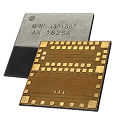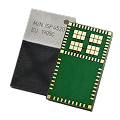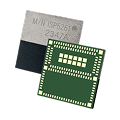Radio frequency (RF) modules are self-contained transmitter, receiver, or transceiver assemblies that provide wireless connectivity for designs ranging from simple remote controls to complex telemetry systems. These radio modules are critical for industries that need reliable wireless links: industrial automation, medical telemetry, Internet of Things (IoT) devices, asset tracking, and telecom backhaul. Online Components maintains broad, authenticated U.S.-based inventory and fast domestic shipping, so engineers and procurement teams can count on verified parts and predictable fulfillment when schedules are tight. That availability and supplier authentication reduce risk throughout prototyping and production, letting teams focus on performance instead of sourcing headaches.
Our RF modules catalog covers short-range Bluetooth and Zigbee modules, 2.4 GHz Wi-Fi modules, sub-GHz Industrial, Scientific, and Medical (ISM) band radios, cellular modules (Fourth-Generation LTE and Fifth-Generation 5G), and higher-frequency microwave link modules. We list products from major manufacturers and include single-chip transceivers, integrated-antenna modules, development kits, and both surface-mount and through-hole variants. Important specifications to watch include frequency band, modulation, output power, receiver sensitivity, data rate, and interface, such as, Universal Asynchronous Receiver/Transmitter (UART), Serial Peripheral Interface (SPI), or Universal Serial Bus (USB). Datasheets, certification notes, and stock counts are available alongside each part so you can compare options efficiently.
How to Choose the Right RF Modules
Start by matching frequency band and regulatory requirements to your target region: picking the wrong band invites interference and compliance trouble. Second, decide integration level: do you need a smart modem that handles protocol stacks, or a raw transceiver that gives an MCU (microcontroller unit) full control? Third, evaluate link-budget factors: required range, receiver sensitivity, and transmit power must align with your physical deployment, and antenna choice or placement often dictates real-world performance more than raw specs.
Popular Applications for RF Modules
RF modules power industrial automation and remote monitoring, supporting wireless sensor networks and control loops where cabling would be impractical or costly. In medical and health telemetry, reliable low-latency radio links transmit patient data securely from bedside devices to central systems. Consumer and commercial IoT applications: smart home devices, wearables, and asset trackers rely on compact, low-power modules for long battery life. Telecom and broadband backhaul use higher-frequency microwave modules for point-to-point links where bandwidth and line-of-sight reliability matter.
Why Buy RF Modules from Online Components?
Online Components pairs authenticated inventory with U.S.-based shipping and responsive customer service to simplify procurement. Our product pages show manufacturer details, certifications (e.g., FCC, CE), datasheets, and live stock so you can confirm compliance and lead time before you order. We support single-unit buys for prototyping and bulk ordering for production, and our specialists can validate supplier provenance on request.
RF Modules: What You Need to Know
What frequency bands do RF modules commonly use?
RF modules commonly operate in ISM bands (433 MHz, 868 MHz, 915 MHz), 2.4 GHz for Wi-Fi/Bluetooth/Zigbee, and licensed cellular bands for wide-area coverage; choose based on range, data rate, and regional rules.
Do RF modules require external antennas?
Some modules include integrated antennas or antenna pads; many production designs use external tuned antennas for consistent, higher-range performance.
How do I confirm regulatory compliance for a module?
Check the module datasheet and certification notes for FCC, CE, or other regional approvals; using a certified module can simplify end-product compliance but doesn't eliminate final-device testing.
Can I prototype with a module before committing to a custom RF design?
Yes: development kits and certified RF modules let you validate radio performance and firmware before moving to custom integrations, reducing risk and time to market.
contact us
 English
English
 Chinese
Chinese
 Italiano
Italiano
 Portuguese
Portuguese
 Deutschland
Deutschland
 French
French
 Russian
Russian
 Japanese
Japanese
 Turkish
Turkish
 Korean
Korean
 Spanish
Spanish



